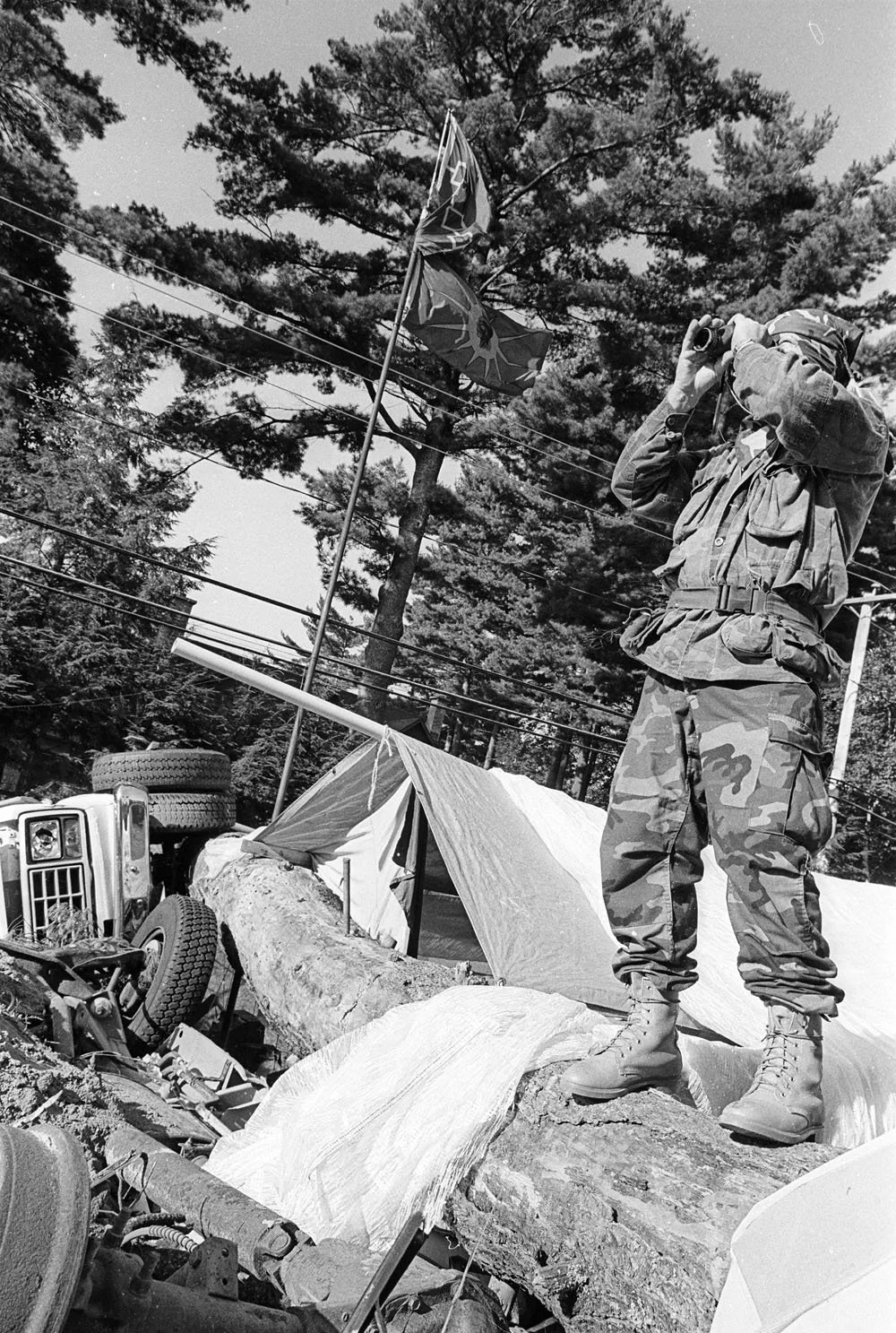They would have killed me
A Mohawk Warrior, equipped with communication devices. (credit. Canadian Archives)
Story told by Só:se Raientonnis
During the Siege of Kanehsatà:ke in 1990, it was a very bad situation in Kahnawà:ke. People were starving. My wife had to go to Dorval by boat to get vegetables. We didn’t even have gasoline. There were some people who smuggled gas in and sold it at a stand by the side of the road.
I was starting to get old, so to help with the efforts, they posted me on the top of the hospital roof with a two-way radio. It was a junk radio though and was way too heavy. They asked me to report on any kind of strange movement along the Seaway, because there was a clear view from the top there.
I never saw anything out of the ordinary except for this one night. There was a helicopter coming from the opposite direction of the water. I saw them coming with no lights, I could tell it was an army helicopter.
The helicopter made a sharp turn and came right for me. I knew they had night vision goggles on, they were definitely able to see me. So, I just stood there, and they flew about 10 feet above my head.
I had a .45 automatic pistol on me. They couldn’t see it though because I carried it tucked in a holster behind my back.
Maybe that’s what saved my life. I’m sure if they had seen the gun in my hand, they would have killed me.
KANIEN’KÉHA VERSION
↓
KANIEN’KÉHA VERSION ↓
Tó:kenske' aionkérioke'
Standing tall by the blockade, a Mohawk Warrior keeps surveillance through his binoculars. circa 1990, during the Kanehsatake crisis. (court. Canadian Archives)
Só:se Raientonnis ROKÁ:RATON
Sha'thatinatáhnhake' Kanehsatà:ke 1990 shitiohserò:ten, é:so tsi wahonaterihwanorónsten' ne Kahnawà:ke. Wahontonhkarià:khon' nón:kwe. Ó:nen'k tsi Dorval niahà:'en' ne khekstén:ha naiekóha' ase'shòn:'a. Kwah iah othé:nen kén:ie teionkwaién:tahkwe' ò:ni'. Ronátia'ke' nón:kwe atahsehtòn:ke tahatí:ion'te' kén:ie tánon' tsi teietástha' nón:we wahontenhní:non' nohahaktóntie'.
Ó:nen shiiotahsawátie' akatia'tísa', né: ká:ti ok ní:ioht wa'kherì:wawa'se', tsi iakenheion'taientáhkhwa' è:neken tsi karonhkwe'náhere ia'tiónktaste' tekawennontáhkwen iontewennaniehtáhkhwa' khá:wi. Iotenonhwénhserote' thí:ken iontewennaniehtáhkhwa' tánon' sótsi iókstehkwe'. Wa'onkerihwanón:tonhse' akheiahronkà:ten' othé:nen taontierónnion'ne' tsi ní:ioht tsi iotorià:neron ne Kana'tsheratátie', ase'kén eh niió:re' ieió:ken tsi karonkwe'náhere' nonkwá:ti.
Iah nonwén:ton tewakatkáhthon othé:nen teiotierónnion, nek kí:ken énska wahsontá:tehkwe'. Tekaweiatá:se's teká:tens ákte' nonkwá:ti tsi kaniataráhere' nontaiawenonhátie'. Wa'khé:ken ken' nontahonenonhátie' iah tekahahserotátie', wakattokahstsíhon tsi kahsotahrha'kéha tekaweiatá:se's teká:tens thí:ken.
Io'shátste' wa'kakarenhrá:ko' thí:ken tekaweiatá:se's teká:tens tánon' io'shátste' tontontia'tóia'ke'. Wakaterièn:tarahkwe' tsi tewahsontathè:tha' tehonatkahráhnhen, orihwiiohón:we aiónkken'. Kheh ítkete', tánon' oié:ri niwahsì:take è:neken tsi wakatenontsístate' tahatítie'.
.45 wateneniatenià:tha' wakathón:rane'. Iah tehonatkáhthon' ase'kén iehonrata'asthà:ke wa'kò:roke' khsòn:ne nonkwá:ti.
Ki' ónhte nè:'e sontia'tanónstate'. Orihwí:io wakaterièn:tarahkwe' tsi tóka' ahonatkáhthon tsi wakathón:rane', tó:kenske' aionkérioke'.
Edited by: Kassidy Jacobs, Local Journalism Initiative Reporter
Translated by: Karonhí:io Delaronde


